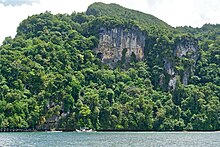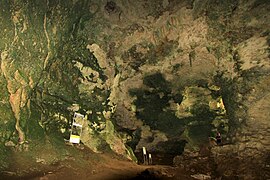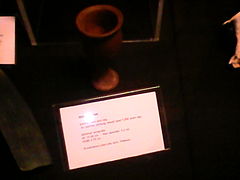
A ship burial or boat grave is a burial in which a ship or boat is used either as the tomb for the dead and the grave goods, or as a part of the grave goods itself. If the ship is very small, it is called a boat grave. This style of burial was practiced by various seafaring cultures in Asia and Europe. Notable ship burial practices include those by the Germanic peoples, particularly by Viking Age Norsemen, as well as the pre-colonial ship burials described in the Boxer Codex in the Philippines.

Maitum, officially the Municipality of Maitum, is a 2nd class municipality in the province of Sarangani, Philippines. According to the 2020 census, it has a population of 44,185 people.
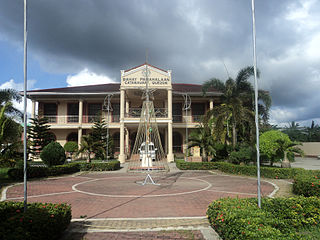
Catanauan, officially the Municipality of Catanauan, is a 1st class municipality in the province of Quezon, Philippines. According to the 2020 census, it has a population of 72,752 people.

Quezon, named by the late President Manuel L. Quezon and officially named the Municipality of Quezon, is a first-class municipality in the province of Palawan, Philippines. According to the 2020 census, it has a population of 65,283 people.
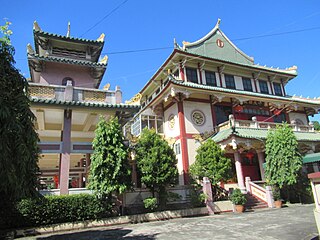
Buddhism is a minor religion in the Philippines. It is practiced by 2% of the population in 2020, primarily by Filipinos of Chinese descent.

Tabon Man refers to remains discovered in the Tabon Caves in Lipuun Point in Quezon, Palawan in the Philippines. They were discovered by Robert B. Fox, an American anthropologist of the National Museum of the Philippines, on May 28, 1962. These remains, the fossilized fragments of a skull of a female and the jawbones of three individuals dating back to 16,500 years ago, were the earliest known human remains in the Philippines, until a metatarsal from the Callao Man discovered in 2007 was dated in 2010 by uranium-series dating as being 67,000 years old. However, some scientists think additional evidence is necessary to confirm those fossils as a new species, rather than a locally adapted population of other Homo populations, such as H. erectus or Denisovan.

Palawan, the largest province in the Philippines, is home to several Indigenous ethnolinguistic groups namely, the Kagayanen, Tagbanwa, Palawano, Taaw't Bato, Molbog, and Batak tribes. They live in remote villages in the mountains and coastal areas.
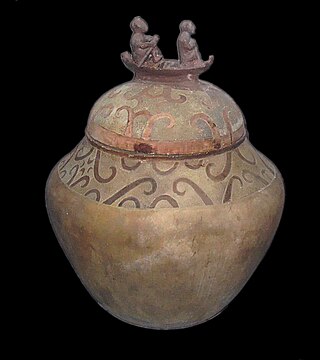
The Manunggul Jar is a secondary burial jar excavated from a Neolithic burial site in the Manunggul cave of the Tabon Caves at Lipuun Point in Palawan, Philippines. It dates from 890–710 B.C. and the two prominent figures at the top handle of its cover represent the journey of the soul to the afterlife.
Robert Bradford Fox (1918–1985) was an anthropologist and leading historian on pre-Hispanic Philippines.

The prehistory of the Philippines covers the events prior to the written history of what is now the Philippines. The current demarcation between this period and the early history of the Philippines is April 21, 900, which is the equivalent on the Proleptic Gregorian calendar for the date indicated on the Laguna Copperplate Inscription—the earliest known surviving written record to come from the Philippines. This period saw the immense change that took hold of the archipelago from Stone Age cultures in 50000 BC to the emergence of developed thalassocratic civilizations in the fourth century, continuing on with the gradual widening of trade until 900 and the first surviving written records.
Dewil Valley, located in the northernmost part of Palawan, an island province of the Philippines that is located in the Mimaropa region, is an archaeological site composed of thousands of artifacts and features. According to the University of the Philippines Archaeological Studies Program, or UP-ASP, the closest settlement can be found in New Ibajay, which is covered by the town capital of El Nido, which is located around 9 km (5.6 mi) south-east of Dewil Valley. Physically it measures around 7 km (4.3 mi) long, and 4 km (2.5 mi) wide. It is in this place which the Ille Cave, one of the main archaeological sites, can be found. It is actually a network of 3 cave mouths located at its base. It has been discovered that this site in particular has been used and occupied by humans over multiple time periods.

Sarangani is a province located in the Mindanao region of the Philippines and has a total land area of 4,441.79 square kilometers.. Historically, Sarangani already had an established community even before the Westerners came. The early Sarangani society was greatly affected by the Indian and Muslim cultures, and the first inhabitants were the indigenous natives called

The Limestone Tombs of Kamhantik is an excavated remains of a thousand-year-old barangay found in the jungles of Mount Maclayao in Sitio Kamhantik within the Buenavista Protected Landscape of Mulanay, Quezon, Philippines. It is widely believed that pre-colonial Tagalog people were responsible for the creation of the tombs.
Shell tools, in the archaeological perspective, were tools fashioned by pre-historic humans from shells in lieu of stone tools. The use of shell tools during pre-historic times was a practice common to inhabitants of environments that lack the abundance of hard stones for making tools. This was the case with the islands surrounding the Pacific, including the Philippines. Shells were fashioned into tools, as well as ornaments. From adzes, scoops, spoons, dippers and other tools to personal ornaments such as earrings, anklets, bracelets and beads. These different artefacts made of shells were unearthed from various archaeological sites from the country.

The archaeology of the Philippines is the study of past societies in the territory of the modern Republic of the Philippines, an island country in Southeast Asia, through material culture.
Philippine ceramics are mostly earthenware, pottery that has not been fired to the point of vitrification. Other types of pottery like tradeware and stoneware have been fired at high enough temperatures to vitrify. Earthenware ceramics in the Philippines are mainly differentiated from tradeware and stoneware by the materials used during the process and the temperature at which they are fired. Additionally, earthenware and stoneware pottery can generally be referred to as ceramics that are made with local materials, while tradeware ceramics can generally be referred to as ceramics that are made with non-local materials.
Symbolism is an abstract meaning given to an object or representative of one. Symbols can define certain aspects of cultures making them initially exclusive to particular groups. When it comes to symbolism in archaeology, artifacts found may display iconography with these abstract symbols or tell us more about the people who made them through their construction. Symbolism is not limited to only inanimate objects but can be found in the actions or being of living things as well. The Philippines, comprising more than 7,000 islands, is an archipelago where symbols of the past and present contribute to its unique culture. These symbols are influenced by and noticeable in burial practices, rituals, social status, architecture, agriculture, and The Philippines' place in the Austronesian world.

The Guyangan Cave System is a group of caves located in the island municipality of Banton, Romblon in the Philippines. It is located in Guyangan Hill, a limestone formation situated in barangays Togbongan and Toctoc, and consists of seven caves spread in an 85.3-hectare (211-acre) area of forest land.
The Palawan Passage is a natural waterway in the southeastern South China Sea to the west of the island of Palawan in the Philippine Islands. It is deep and relatively free of navigational hazards, making it an important shipping route. The entire Palawan Passage lies within the exclusive economic zone of the Philippines and in waters the Government of the Philippines refers to as the West Philippine Sea.
